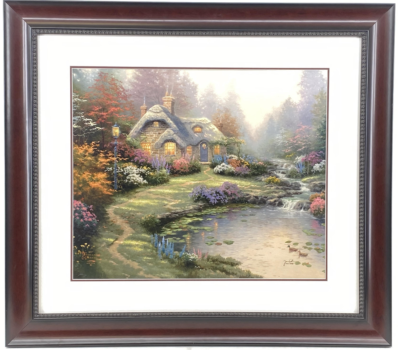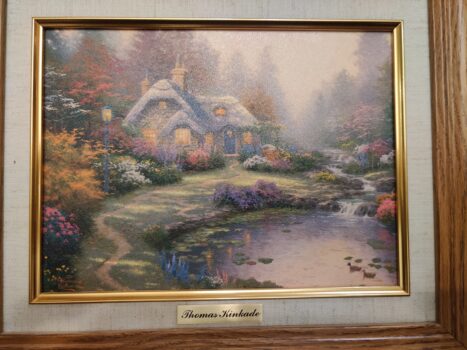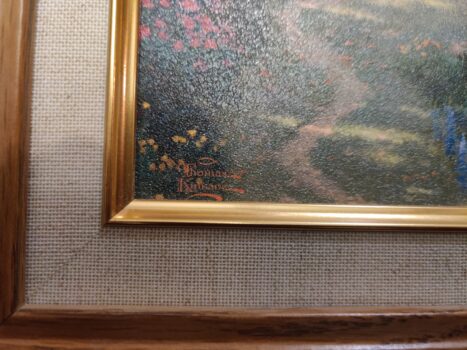This art appraisal report offers an in-depth and impartial assessment of the artwork in question, grounded in the appraiser’s expertise and familiarity with the art market. All the information and data analyzed in this report is sourced solely from the client.
Having a clear understanding of the value of your artwork is crucial in making informed decisions about its future. This report provides a precise estimate of the value of each piece, using US dollars as the base currency. It is not intended to encourage the sale of the artwork, but rather to provide valuable information on how to proceed should the client decide to do so in the future.
Detailed description of the artwork, including its medium, dimensions, and condition.
Checking Originality: Identification with Artificial Intelligence Test
In the quest to identify a match, Image Search employs advanced AI techniques to scour databases of images in order to find visually similar images. This is achieved through the use of various algorithms such as pattern recognition and machine learning. While some results may be considered as “matches” due to a clear similarity, other results may be inconclusive as they rely more on chance rather than any specific similarities. To conduct this test, a front-facing image was used as a reference to search for similar images on the internet.
The results of the automatic recognition are not conclusive. If a match is found, it will be shown below:

What specific information can we obtain from this test?
The algorithm found an exact match. This result is associated with prints, either regular or limited edition prints, that were hand signed by the original artist of this piece of art. It’s important to determine what type you have, so I need to go through the research and inspection process.
This is a limited edition print by listed artist Thomas Kinkade titled “EVERETT’S COTTAGE”.
Age estimation
In order to determine the age of the painting in question, it is important to consider the frame construction, color palette used, and other characteristics of the work. In this case, the painting is a limited edition print by the listed artist Thomas Kinkade, who was born in 1958 and passed away in 2012. This provides us with a general timeline of when the artwork was created, as it is unlikely that it was created before 1958 or after 2012. We can also look at the frame construction to determine the age of the painting. A wooden frame with ornate details, such as the one used in this painting, was very popular in the late 1980s and early 1990s. The colors used in the painting also provide clues to its age. Vibrant colors such as the blues and purples used in this painting were often used in paintings of the late 1980s and early 1990s. Therefore, based on the evidence provided, this painting was likely created during that time period.
Based on this information and the pictures provided, I can estimate this painting was made late 20th Century.
Condition of the artwork
This limited edition print by the listed artist Thomas Kinkade (1958-2012) titled, "Everett's Cottage" is in excellent condition and does not require any restoration. There is no appreciable damage and any minor damage present is minimal. This artwork is an excellent example of the artist's keen eye for detail and a testament to his skill as a painter. It is a true pleasure to admire this artwork in its pristine condition.
Artist’s name, biographical information, artwork’s provenance (history of ownership) and exhibition history.
I study and research the signature of artwork to see if it matches any known signatures. The artist has already been identified, so I don’t need to study the signature at this point.
Thomas Kinkade was an American painter and printmaker, best known for his paintings of idyllic and tranquil scenes. Born in 1958, Kinkade began his career as a painter in 1982 and quickly became one of the most popular and commercially successful artists of his time. His primary subject was of bucolic and idyllic scenes of American houses and gardens, often with a light that seemed to emanate from within the painting. He was often referred to as the “Painter of Light” due to the glowing effects in his work. His work was widely distributed through prints, posters and various other forms of merchandise. His work was very popular and generated millions of dollars in sales. He died in 2012 at the age of 54.
Detailed analysis of the artwork’s style, subject matter, and significance within the artist’s oeuvre and the broader art world.
I can check if the style and type of painting match those of the artist referenced.
The painting "Everett's Cottage" by Thomas Kinkade (1958-2012) is a stunning example of his distinctive artistic style, which often features soft and glowing colors and a peaceful, idyllic scene. Kinkade's works generally have a dreamy, romanticized atmosphere and focus on traditional images of home, family, and nature. His work often utilizes a variety of light sources to create a sense of warmth and comfort. The limited edition print of "Everett's Cottage" is sure to be a timeless reminder of the beauty and joy of home.
Comparable sales information, including prices realized at recent auctions or private sales of similar works by the artist or in the same medium.
In order to provide an up-to-date estimate of the fair market value for the painting, "Everett's Cottage" by the listed artist Thomas Kinkade (1958-2012), I utilized the data collected, including auction prices and other relevant market information related to the artist's work. This is crucial as it can be used in various contexts such as insurance, estate planning, and art market analysis. It also offers a valuable insight into how the valuation of "Everett's Cottage" may have changed due to environmental or economic factors.
The auction prices were a significant factor in determining the current market value of the artwork, as they are based on actual transactions between buyers and sellers in the art market. As such, they are a strong indicator of the expected value of the piece in the near future.
By analyzing auction results from the last 6 months, I was able to accurately determine the current fair market value of the artwork. This approach provides a comprehensive view of how the value has changed over time and gives insight into any potential areas of appreciation or depreciation in its price. Additionally, it allows me to adjust my valuation as new auction prices become available.
Conclusion
Investing in art can be a great way to diversify one's portfolio while also taking pleasure in owning something beautiful. Art can appreciate in value, as it is considered an asset, and purchasing a piece of artwork can be a great investment. Art is unique and has a personal value to the owner that is unmatched and gives a sense of pride and joy. Additionally, art can be seen as a form of investment in culture. It can be used to preserve the culture and history of an artist or a nation, or to preserve the memories of a beloved family member. Investing in art is also a great way to be philanthropic and support the artists and their work. Investing in art is an excellent way to add value to a portfolio and make a great investment.
The painting can be considered valuable by the art market because it is an original, limited edition print by the acclaimed and listed artist Thomas Kinkade, who was a renowned and renowned artist in the late 20th century. This particular painting, "Everett's Cottage," is a highly sought-after work of art and is likely to appreciate in value over time due to the rarity and popularity of Kinkade's art.
Final Appraisal Value ($)
700-800$
Appraisal Report made by:
Andrés Gómez
BSc, MSc, Expert Art Appraiser
10+ years of experience in Online Art Appraisals
100k+ Customers Served
Antique Store Owner
You can check my portofolio of past appraisals here:
https://www.appraisily.com/andres-portofolio/

Relevant photographs or supporting documentation, such as condition reports or expert opinions
A detailed summary of the appraisal process and the appraiser’s qualifications.
Mark-to-market art appraisal is a vital method for determining the current value of a piece of artwork. This form of valuation requires an appraiser to consider various factors, such as market conditions, the condition and age of the artwork, and the artist’s reputation. By taking all these elements into account, a mark-to-market art appraisal delivers an accurate assessment of a piece of artwork’s current market value.
The artist’s reputation, as determined by their track record in gallery and museum shows, awards, and other accomplishments, is also considered in mark-to-market art appraisal. Appraisers use this information to determine if the value of a piece is likely to increase or decrease over time. Additionally, they will inspect the condition of the artwork and note any signs of wear or damage that might affect its future resale value.
When performing mark-to-market art appraisals, appraisers also consider market conditions by researching current art market trends and comparable works that have recently sold. This information is used to provide an estimate of a piece’s worth at that point in time. By considering all of these factors, mark-to-market art appraisal is able to give a reliable indication of the current value of a work. This kind of valuation can also ensure fair prices are paid and received when buying or selling art.
In summary, mark-to-market art appraisal is a crucial tool for determining the true value of a piece of artwork, enabling buyers, sellers, and appraisers to make informed decisions regarding its worth. It takes into account multiple aspects to provide an accurate assessment of the current market value of a work. This information can be used to ensure that buyers and sellers are getting a fair price for the artwork, and that the appraiser’s valuation is up-to-date and reflective of current market conditions.
In the case of insurance replacement appraisals, mark-to-market art appraisals can also be used to accurately estimate the cost of replacing a lost or damaged artwork. The current value, as determined by the appraisal, is then used to determine the amount that the insurance company will pay back to the policyholder. This way, policyholders can rest assured that they will receive an appropriate sum for any artwork that needs to be replaced due to accidental damage or theft. Additionally, this kind of valuation helps insurers ensure they are not being overcharged when artwork needs to be replaced as part of a claim settlement.
The appraisal process is a thorough evaluation of the item or items in question. It involves researching and analyzing the information provided by the requester in order to provide an accurate estimate of its value. The appraiser takes into account factors such as condition, rarity, demand, and market prices. Photographs and detailed descriptions are especially important when providing an appraisal, since they help the appraiser identify any potential flaws or defects that could affect the item’s worth. By using all the resources that are available, an evaluation can be done quickly, efficiently, and with a high level of accuracy.
A statement of the appraiser’s liability and any potential conflicts of interest.
A qualified art appraisal, also known as a formal written evaluation, is a professional assessment of the monetary value of a piece of art by an individual who has specialized knowledge, expertise, and training in the field of art appraisal. This person must meet certain educational and professional requirements, including experience in researching and evaluating art, as well as knowledge of the art market and current market trends. The purpose of a qualified art appraisal is to provide an objective and unbiased opinion of the value of a piece of art for various purposes, including insurance claims, tax planning, estate planning, or to help determine a fair price for a sale or purchase.
We are committed to providing our clients with the most accurate and unbiased appraisal reports. To ensure impartiality, we adopt a flat rate, fixed fee structure for all appraisals, instead of a percentage-based fee. This eliminates any potential conflicts of interest between the art appraiser and the final report value. Our appraisal reports are in compliance with the Appraisal Foundation’s USPAP (Uniform Standards of Professional Appraisal Practice) standards and guidelines, which are widely accepted as the ethical and performance standards for appraisers. This guarantees that our reports are of high quality and legally defensible.
How to sell this artwork.
We have a structured guide to help you sell your artwork, you can find it here.










